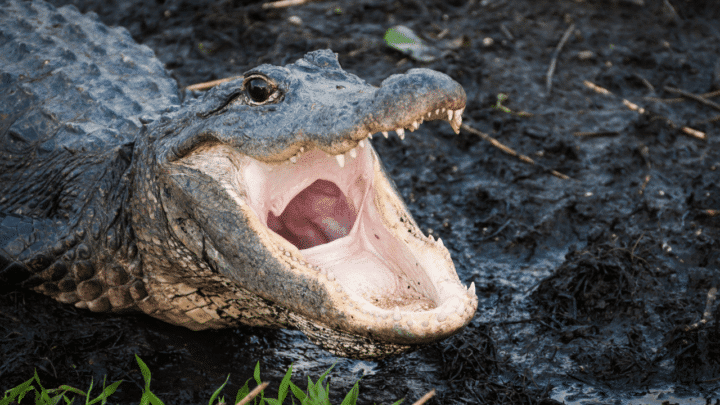It’s not every day that we spot an alligator outside our homes, so it is no surprise that there are many things that we don’t know about them.
In this article, you’ll learn the answer to one of the most mind-boggling questions about alligators. Do alligators have a tongue? Read below to find out.
Do Alligators Have A Tongue?
Yes, alligators have tongues. Just like crocodiles, alligators cannot stick their tongue out. However, they do not have salt glands on their tongue, so they need to transfer back and forth between freshwater and marine ecosystems to maintain balance in their salt levels. Their tongue can be found in the lower mouth, and its length is almost the same as the alligator’s snout, which is about 2 feet long.
A palatal valve can be found at the back of their tongue, which serves as the seal to stop air or water from getting in. This is important to prevent fluids from reaching their stomach or lungs.
The palatal valve also helps the alligator in hunting and catching prey that is found below the surface. Through closing the seal, an alligator can fully open its mouth when submerged, and can easily catch its prey.
Just like its other body parts, an alligator’s tongue serves a vital part in its feeding and survival.
What is an Alligator?
Alligators are reptiles that are commonly confused with crocodiles. They are large and have powerful tails that they use for swimming and defense.
Their nostrils, ears, and eyes are located on top of their head. They are carnivorous and can weigh up to 1000 pounds.
Alligators dig burrows that they use for resting and for avoiding extreme weather. They commonly live up to 50 years in the wild and can live up to 70 years in captivity.
Types of Alligators
There are two types of alligators, which are: American Alligator (Alligator mississippiensis) and Chinese Alligator (Alligator sinensis).
The Chinese Alligator is the lesser-known type that is commonly found in China’s Yangtze River.
It is smaller and has an average length of 1.5 meters, and can grow up to 2.1 meters or 7 feet. It is black in color and has markings that are faint yellow.
Less than 100 of their kind remain in nature, therefore they are considered critically endangered according to the International Union for Conservation of Nature and Natural Resources (IUCN).
American Alligators are larger and are typically found in the southeastern United States. A young American Alligator appears black in color with yellow banding.
However, when it becomes an adult, its color changes to brown. Its normal length is 1.8-3.7 meters, but its maximum length is 5.8 meters.
Prehistoric Characteristics
Based on the physical characteristics of alligators, which are: armored skin, strong jaws, lizard-like bodies, and powerful tails, they seem to be a remnant of a distant past.
According to scientists, alligators are more than 150 million years old. They were able to avoid extinction, unlike their predecessors, the dinosaurs, who died 65 million years ago.
The salvation of American Alligators
Originally, American Alligators have been hunted for their skin, and many young alligators have been sold as pets.
They were endangered and due to human effort, they are now thriving in numbers.
Federal and state protections were given, habitat preservation was given utmost importance, and a decrease in demand for alligator products helped increase the species’ population to more than 1 million and growing.
Habitat
Alligators are typically found in permanent bodies of water, such as swamps, lakes, marshes, and rivers.
Due to their long stay in the water, they became great swimmers. Their speed in water can reach 20 mph, which is faster than a bottlenose dolphin.
They can also walk fast on land for about 35 mph, but staying too long out of the water may risk their life.
Reproduction and Offsprings
Alligators have strong maternal instincts and are very protective of their babies. They build a comfortable nest to provide warmth to the eggs.
The mother alligator will not leave the nest during the incubation period of 65 days. When the eggs are about to hatch, their mother will cautiously carry each egg from the nest to the water.
The young alligators are 6-8 inches in length and have black and yellow stripes. They typically stick around with their mothers for 2 years.
Food Consumption
Alligators are apex predators that are vital to the biodiversity of the ecosystem. These carnivores mostly eat fish, mollusks, snakes, turtles, small mammals, as well as other reptiles. When it is very hungry, it can eat almost anything, which includes: fruits, pets, carrion, and sometimes, humans.
Difference Between Crocodiles and Alligators
Even though they are similar to one another, you can still differentiate the two species by looking at some of their characteristics.
A crocodile has a narrow V-shaped snout, and a large tooth from each side of the lower jaw can be seen, even when its mouth is closed.
A mouth of a crocodile has a membrane that keeps its tongue on the roof so it doesn’t move. Therefore, they cannot stick their tongue outside their mouth.
This is advantageous for the crocodile when it rapidly closes its mouth. They would not be able to cut their own tongue while eating their prey.
They can live in freshwater and saltwater. They have glands on their tongue that excrete salt to allow them to survive in saltwater.
Alligators can only survive in freshwater. They have a broad U-shaped snout and all of the teeth in their lower jaw fit within those of the teeth from the upper jaw. When their mouth is closed, no lower teeth can be seen.


